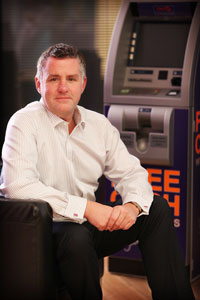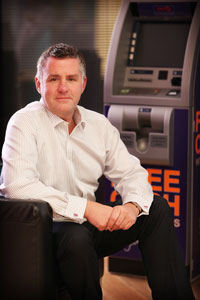How the ATM positively contributes to retail businesses and the hidden benefits the service provides by Ewan Ogilvie, Managing Director for UK and Europe.
The inventor of the Automatic Teller Machine (ATM) is much contested, with the likes of Luther George Simjian, John Shepherd-Barron, James Goodfellow, Don Wetzel, John D. White and Jairus Larson all being quoted as the forefathers of the machine that last year, in the UK, dispensed over £122 billion in cash.
The vast majority of UK ATMs are part of the LINK network, which regulates all ATM providers, from the major banks to the independent ATM deployer (IAD) and supports the circa 100 million LINK-enabled cards that are currently in circulation.
Before 1999, banks were the only providers of ATMs and once the regulations on providing ATMs changed, the market opened up for the IADs. The number of independently deployed ATMs rose exponentially and today we have over 65,500 ATMs in the UK market that are split equally between the IADs and banks.
In a society which is driven by budgets, value for money and the tangibility of having physical cash; cash usage has unsurprisingly increased and still remains the preferred payment method for the UK public. An article in the Telegraph (11th June 2013) stated that budgeting shoppers ditched their debit and credit cards in favour of cash…and with banks reducing the number of remote bank branches, IADs are now able to offer retail businesses, a cost effective route for their customers to access cash, whilst offering the business owner a number of additional benefits.
In September last year I attended a conference that highlighted how the majority of the convenience chains, including the likes of Spar, Premier and Nisa, are all striving to create a ‘community hub’ for their customers. This was done by offering their customers’ things like locally grown produce, bread baked on-site and additional services such as parcel pick-up or providing an ATM. It now seems the ATM has become an essential part of this hub proposition, with customer expectations changing and the provision of an ATM now the ‘norm’…which ATM deal is right for you?
The benefits of an ATM, in a retail business, are numerous and include increased footfall, increased basket spend, increased impulse buying and more importantly the creation of a ‘community hub’. Statistics, that are regularly quoted, tell us that when a customer has withdrawn cash from an in store ATM, their spend increases by an average of 65%.
The ATM industry has 2 main propositions for ATM services; a through the wall (TTW) ATM or an internal lobby style ATM, and it will depend on the business as to which will suit, though be mindful, a TTW ATM requires planning permission, tends to be disruptive to the business and has a larger footprint in the retail space due to the Cash in Transit (CiT) security requirements when compared to its smaller brother. An internal lobby ATM will need, at the very minimum, power and in some cases, a phone line. Then consideration must be made regarding the provision of cash to the ATM…do you choose a CiT option, which means that the cash to fill the ATM is delivered by a third party supplier or go for Merchant Replenishment, essentially using the business owners own cash, taken over the till, to fill the ATM?
Careful thought needs to be made for each of these business models, and whilst YourCash are able to supply both propositions, in most cases we champion the merchant replenishment option. Not only does this ensure the ATM is a cost effective solution for both parties, it also allows the owner to enjoy reduced business banking fees, as they load the ATM with their cash, rather than banking it. Also don’t forget, you don’t have to walk to the bank to deposit the cash or arrange for it to be collected. You will find, more often than not, the cash from the ATM will be recycled back into the business as once you have a customer in store, there’s normally something they need. If you remove the cash-back option at the till as well, you could also save on banking/card transaction fees, in addition to speeding up transaction times. Our customers tell us they have saved £1000’s by using the internal, lobby style, merchant replenishment model.
Whilst I’ve said a lot about convenience stores, we also see demand for merchant replenished ATMs in several other types of location, such as petrol stations, department stores, coffee shops, discount retailers, garden centres and farm shops – essentially anywhere that has high footfall and sufficient cash to stock the ATM, on a daily basis.
However you look at it, the ATM is here to stay and is a genuine business ally, with nothing to lose, but plenty to gain. New ATM technologies are being developed on a regular basis and the services an ATM provides will increase and enhance the consumer experience. It really will become an essential part of the retail business kit bag.



